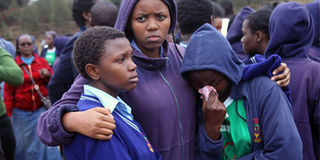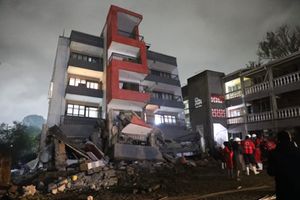School fires: Let us stand up for children by holding ourselves and officials to account

Students of Moi Girls' School Nairobi in a sombre mood after a fire broke out in one of their dormitories killing nine students. It is appalling that nine years since the “School safety standards manual” was unveiled, the threats that were to be eliminated by these measures still claim lives in schools. PHOTO | ANTHONY OMUYA | NATION MEDIA GROUP
What you need to know:
It is appalling that nine years since the “School safety standards manual” was unveiled, the threats that were to be eliminated by these measures still claim lives in schools.
This year, the Education ministry received a report from a task force led by secretary of administration in the office of the president Claire Omolo.
It is, therefore, incumbent upon education stakeholders to draw lessons from the past and right the wrongs in the sector.
In 2008, the Ministry of Education developed a blueprint for enhancing the safety of learners in schools. According to then Education Secretary, Prof George Godia, threats to learners required to be addressed through carefully thought-out measures and strategies.
It is appalling that nine years since the “School safety standards manual” was unveiled, the threats that were to be eliminated by these measures still claim lives in schools.
The Education ministry leads other ministries and government agencies in developing and unveiling laws, policies, frameworks and documents that are never put to use — not to mention the numerous commissions established to streamline the sector since independence.
What happened at Moi Girls School Nairobi last weekend is not acceptable and should not happen again in any learning institution if the various duty bearers are worth the titles they hold.
CLEAR GUIDELINES
The safety standards manual for schools is clear in identifying the dormitory as the single most used physical infrastructure in a boarding school.
The manual is elaborate — including specifics on the requisite space between beds, size of corridors, the size of doors (not less than 5 feet wide and should open outwards). It also states clearly that the doors should not at any time be locked from outside when learners are inside.
The guidelines are so clear that they indicate where the key should be kept and that windows should be without grilles and should be easy to open outwards.
They go on to specify the necessary firefighting equipment needed; number of doors and where they should be placed.
The guidelines end by emphasising regular patrols by the school security personnel or and state that no visitor should be allowed in the dormitory.
LETHARGY
From the preliminary reports out of the Moi Girls tragedy, the logical conclusion is that there exists lethargy at three levels: The Education officials responsible for enforcing safety standards in Nairobi are present but not on duty hence the lapses, the school management has not fully implemented the guidelines and did not conduct frequent drills as guided and the adults on duty during the emergency were not present or did not know what to do since they have not been trained.
This year, the Education ministry received a report from a task force led by secretary of administration in the office of the president Claire Omolo.
The report was clear that the ministry needs to strengthen its monitoring unit to manage the sector better.
One of the things the task force delivered on was safety and security. What we have seen since the report was handed over is more lethargy.
TAKE RESPONSIBILITY
As a country, we need to learn to take responsibility for the acts of omission or commission undertaken during our tenure. If we do not learn, we cannot change this nation.
In 1976, Prof Kabiru Kinyanjui, now Chancellor Chuka University, wrote a well thought-out research paper on the secondary school strikes that occurred in 1974 — when more than 100 schools were razed by striking students.
What is interesting about the paper is not only the title — Secondary School Strikes: The Art of Blaming the Victim — but also the framing of the issues by the media and how adults who supervise the children are let off the hook.
Looking at the latest tragedy, you get the feeling that the media is already passing judgement on the student suspected to have started the fire (who may or may not be guilty) without asking three critical questions from the emerging accounts: How long had the Form One student showed signs of distress and were there any support mechanisms? Were her parents notified and what was their reaction? Was she on the school’s watch list?
COMMUNICATION
By failing to ask these questions, we are getting into a framing trap in which we will eventually get to blame the victim as Prof Kinyanjui concluded.
It is, therefore, incumbent upon education stakeholders to draw lessons from the past and right the wrongs in the sector.
What, for example, are the parent engagement frameworks in our schools? Many of the large schools have choreographed meetings where a few elitist people manage the agenda and resolutions.
Schools need to open up and have alternative channels of communication to avoid the obfuscation of issues and provide genuine support to learners to vent and learn from mistakes. The current system of learners electing their leaders is a charade.
We have to stand up for our children by holding ourselves and the education sector to account.
The writer is the Country Director, Discovery Learning Alliance-Kenya Email:[email protected]





